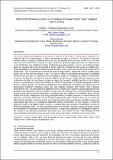| dc.contributor.author | Ondoro, Charles O | |
| dc.contributor.author | Omena, Dorine | |
| dc.date.accessioned | 2018-01-15T12:59:52Z | |
| dc.date.available | 2018-01-15T12:59:52Z | |
| dc.date.issued | 2012 | |
| dc.identifier.uri | https://repository.maseno.ac.ke/handle/123456789/76 | |
| dc.description.abstract | The current global youth population is the largest in history. Of the world’s 3 billion people estimated to be under the age of 25, approximately 1.3 billion are between the ages of 15 and 24. This group is faced with imminent poverty. Attempts to alleviate the youth from this poverty level have been carried out in as many places as are the methods. For example, it is agreed that loans, by increasing family income, can help the youth to accumulate their own capital and invest in employment-generating activities. However, as development takes place, one question that arises is the extent to which credit can be offered to these youths to facilitate their taking advantage of the developing entrepreneurial activities, which in turn can help in efforts to fight poverty among them. This is because poverty among the youth is still prevalent. Under half of the 1.3 billion young people live on less than two dollars a day. This state of affairs is particularly pronounced in developing countries such as Kenya. In response to this the research sought to investigate the effects of microfinance services on the financial empowerment of youth in Migori County in Kenya. Specifically, the researcher sought to determine the effect of micro-finance services on savings by the youths, establish the effect of micro-finance services on investments by youths and ascertain the effect of micro-finance on financial management skills of youths in Migori County. The researcher targeted the 339 microfinance beneficiary youth groups and 513 microfinance beneficiary individual youths who had obtained financing from Kenya Youth Enterprise Development Fund. The study followed a descriptive survey. Random and Purposive sampling approaches were adopted to pick respondents from two clusters. Primary data was obtained using a self administered pretested structured and semi structured questionnaire. Secondary data was obtained from published books, journal articles and reports. Analysis was done using descriptive statistics involving measures of central tendency and dispersion. Chi Square Model was used to establish relative levels of effect. ANOVA was used to compare the effect of micro financing on savings, income levels and investments of the youth between and within groups. The study showed that there is no significant relationship between microfinance services savings or investment among the youth in the Migori County. However, a positive effect was revealed of microfinance services on financial management skills. The study recommends that more training is necessary among the youth to enable them understand the importance of microfinance services. It urges future researchers to investigate the effect of the services on the financial empowerment among the youth over a period of time. These findings will help those articulating youth policy issues and general micro financing practice. It will also excite academicians. | en_US |
| dc.publisher | Business and Management Review | en_US |
| dc.subject | Lending, Group, MFIs, Non Financial Services, Formal credit, Youth Entity, Youth, Youth Empowerment, Youth Enterprise Development Fund | en_US |
| dc.title | Effect of Microfinance Services on the Financial Empowerment of Youth in Migori County, Kenya | en_US |
| dc.type | Article | en_US |

